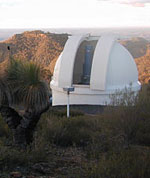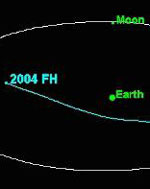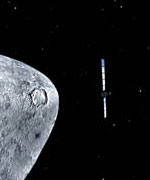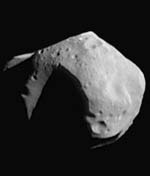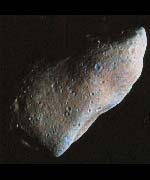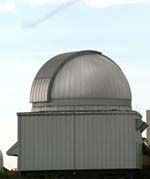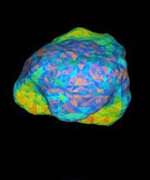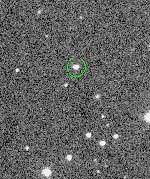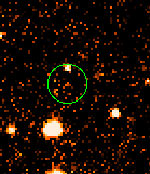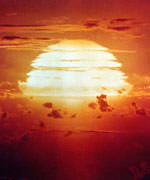
Image credit: US Department of Energy
Next time an asteroid or comet is on a collision course with Earth you can go to a web site to find out if you have time to finish lunch or need to jump in the car and DRIVE.
University of Arizona scientists are launching an easy-to-use, web-based program that tells you how the collision will affect your spot on the globe by calculating several environmental consequences of its impact.
Starting today, the program is online at http://www.lpl.arizona.edu/impacteffects .
You type in your distance from the predicted impact site, the size and type of projectile (e.g. ice, rock, or iron) and other information. Then the Earth Impact Effects Program calculates impact energies and crater size. It next summarizes thermal radiation, seismic shaking, ejecta deposition (where all that flying stuff will land), and air-blast effects in language that non-scientists understand.
For those who want to know how all these calculations are made, the web page will include “a description of our algorithm, with citations to the scientific sources used,” said Robert Marcus, a UA undergraduate in the UA/NASA Space Grant Program. He discussed the project recently at the 35th Lunar and Planetary Science Conference meeting in Houston, Texas.
Marcus developed the web site in collaboration with planetary sciences Regents? Professor H. Jay Melosh and research associate Gareth Collins of UA?s Lunar and Planetary Laboratory.
Melosh is a leading expert on impact cratering and one of the first scientists reporters call when rumors of big, Earth-smashing objects begin to circulate.
Reporters and scientists both want to know the same thing: how much damage a particular collision would wrack on communities near the impact site.
The web site is valuable for scientists because they don’t have to spend time digging up the equations and data needed to calculate the effects, Melosh said. Similarly, it makes the information available to reporters and other non-scientists who don’t know how to make the calculations.
“It seemed to us that this is something we could automate, if we could find some very capable person to help us construct the website,” Melosh said.
That person turned out to be Marcus, who is majoring in computer engineering and physics. He applied to work on the project as a paid intern through the UA/NASA Space Grant Program.
Marcus built the web-based program around four environmental effects. In order of their occurrence, they are:
1) Thermal radiation. An expanding fireball of searing vapor occurs at impact. The program calculates how this fireball will expand, when maximum radiation will occur, and how much of the fireball will be seen above the horizon.
The researchers based their radiation calculations on information found in “The Effect of Nuclear Weapons.” This 1977 book, by the U.S. Defense Department and U.S. Department of Energy, details “considerable research into what different degrees of thermal radiation from blasts will do,” Melosh noted.
“We determine at a given distance what type of damage the radiation causes,” Marcus said. “We have descriptions like when grass will ignite, when plywood or newspaper will ignite, when humans will suffer 2nd or 3rd degree burns.”
2) Seismic shaking. The impact generates seismic waves that travel far from the impact site. The program uses California earthquake data and computes a Richter scale magnitude for the impact. Accompanying text describes shaking intensity at the specified distance from the impact site using a modified Mercalli scale This is a set of 12 descriptions ranging from “general destruction” to “only mildly felt.”
Now suppose the dinosaurs had this program 65 million years ago. They could have used it to determine the environmental consequences of the 15-kilometer-diameter asteroid that smashed into Earth, forming the Chicxulub Crater.
The program would have told them to expect seismic shaking of magnitude 10.2 on the Richter scale. They also would have found (supposing that the continents were lined up as they are now) that the ground would be shaking so violently 1,000 kilometers (600 miles) away in Houston that dinosaurs living there would have trouble walking, or even standing up.
If the Chicxulub Crater-impact occurred today, glass in Houston would break. Masonry and plaster would crack. Trees and bushes would shake, ponds would form waves and become turbid with mud, sand and gravel banks would cave in, and bells in Houston schools and churches would ring from ground shaking.
3) Ejecta deposition. The team used a complicated ballistics travel-time equation to calculate when and where debris blown out of the impact crater would rain back down on Earth. Then they used data gathered from experimental explosions and measurements of craters on the moon to calculate how deep the ejecta blanket would be at and beyond the impact-crater rim.
They also determined how big the ejecta particles would be at different distances from impact, based on observations that Melosh and UA?s Christian J. Schaller published earlier when they analyzed ejecta on Venus.
OK, back to the dinosaurs. Houston would have been covered by an 80.8-centimeter- (32-inch-) thick blanket of debris, with particles averaging 2.8 mm (about 1/8th inch) in size. They would have arrived 8 minutes and 15 seconds after impact (meaning they got there at more than 4,000 mph).
4) Air blast. Impacts also produce a shock wave in the atmosphere that, by definition, moves faster than the speed of sound. The shock wave creates intense air pressure and severe winds, but decays to the speed of sound while it?s still close to the fireball, Melosh noted. “We translate that decreasing pressure in terms of decibels ? from ear-and-lung-rupturing sound, to being as loud as heavy traffic, to being only as loud as a whisper.”
The program calculates maximum pressures and wind velocities based on test results from pre-1960s nuclear blasts. Researchers at those blasts erected brick structures at the Nevada Test Site to study blast wave effects on buildings. The UA team used that information to describe damage in terms of buildings and bridges collapsing, cars bowled over by wind, or forests being blown down.
Dinosaurs living in Houston would have heard the Chicxulub impact as loud as heavy traffic and basked in 30 mph winds.
Original Source: UA News Release

